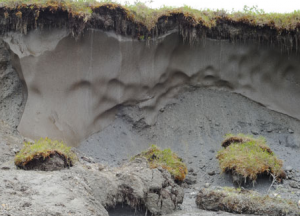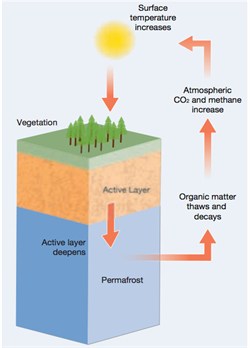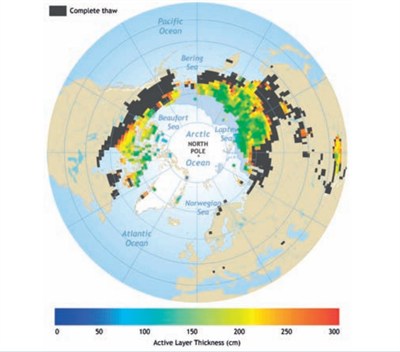Permafrost 101: Why We Need To Account For Thawing Ground In Climate Projections
 Melting permafrost in the Arctic could push the earth towards climate change that is “irreversible on human timescales”, according to a new report…. Here’s our quick guide to what you should know about melting permafrost.
Melting permafrost in the Arctic could push the earth towards climate change that is “irreversible on human timescales”, according to a new report…. Here’s our quick guide to what you should know about melting permafrost.The report, by the United Nations Environment Programme (UNEP), says billions of tonnes of carbon once locked up in permafrost could be released into the atmosphere this century – accelerating global warming. But how much might be released, and how quickly? These questions are still being debated in the scientific community, which means that it’s sometimes hard for media coverage to strike the right balance when discussing how significant the effect could be.
1. What is permafrost?
Permafrost is the name given to permanently-frozen ground in high latitudes. Permafrost acts like a lid, locking frozen carbon deposits deep below ground. The upper layer of permafrost thaws and re-freezes naturally each year. As the carbon thaws, microbes degrade it – a process that releases carbon dioxide and methane.
As atmospheric temperatures rise – due mainly to human activity – heat penetrates deeper into the ground than before. This leads to more permafrost thawing, and more carbon being released to the atmosphere.
2. What does that have to do with climate change?
Scientists are concerned that carbon dioxide and methane released into the atmosphere from permafrost will mean more global warming. Methane is a powerful greenhouse gas – around 25 times more effective at trapping heat than carbon dioxide over a 100-year cycle.
What’s more, this additional warming can create a vicious circle. Extra warming thaws more permafrost, leading to further warming – and so on. Scientists call a self-reinforcing warming cycle like this a positive feedback.
This has important consequences for limiting climate change – it’s already looking increasingly unlikely that warming can be limited to two degrees above pre-industrial levels – the internationally accepted target. An additional source of greenhouse gases from permafrost further reduces the chances of hitting that target.

The positive feedback from thawing permafrost amplifies existing atmospheric warming due to human activities. Source: UNEP report “Policy Implications of Warming Permafrost”.
3. Don’t scientists know about melting permafrost already?
Yes, scientists have already raised concern that rising temperatures could thaw part of the vast reservoir of frozen methane along continental shelves and undersea in the Arctic and, more recently, in the Antarctic.
But there is a lot of uncertainty about how big the global reservoir is and how much of it is thawing, which we wrote a bit more about here. About 60 per cent of methane in the atmosphere results from human activity, like agriculture and landfill. So far, only a small amount is from melting permafrost. The remaining 40 per cent is released naturally from wetlands.
All of this uncertainty means that the Intergovernmental Panel on Climate Change has been unable to properly account for thawing permafrost in its projections for future global warming.
4. What does the new UNEP report say?
The new report is a synthesis of the most up-to-date scientific research. It says that permafrost covers a quarter of the northern hemisphere and currently stores around 1700 billion tonnes of carbon – almost twice the amount currently present in the atmosphere.
Between 43 and 135 billion tonnes of methane could be released by 2100 as permafrost thaws, according to the report, and by 2200 that number could reach 246 to 415 billion tonnes. These emissions could start now but continue for many centuries, influencing both the short term and long term climate.
Temperatures in the high latitudes are projected to rise twice as fast as the global average. The report warns a three degree world, or six degrees in the Arctic, could melt 30 to 85 per cent of near-surface permafrost. As well as affecting the climate, this would permanently affect local hydrology, alter habitats and could damage critical infrastructure built on melting ground.

One model projection indicates a 59% loss in near-surface permafrost area by 2100 for the IPCC A1B scenario Source: UNEP report “Policy Implications of Warming Permafrost”.
5. Will this push the earth past a tipping point?
The UNEP report warns that the release of carbon from permafrost is essentially irreversible on human timescales. Some media coverage of the UNEP report has suggested that carbon released from melting permafrost could push the climate past a tipping point.
A climatic tipping point is a threshold beyond which the climate undergoes a shift from one physical state to another, and could include things like thawing permafrost, melting of the Greenland ice sheet or the dieback of the Amazon rainforest.
While scientists are confident that such tipping points exist in theory, predicting when they might occur and measuring progress towards them cannot be done with certainty. Research is beginning to provide a clearer picture though – a recent study suggests that some tipping points in the climate may even occur below two degrees of warming.
6. So what should be done about melting permafrost?
To reduce some of the uncertainty on this subject, the report recommends a special IPCC assessment into how emissions from melting permafrost will influence global climate. Countries with substantial permafrost should also create national networks to adequately monitor permafrost carbon release and develop adaptation plans to estimate the costs and risks of permafrost thaw, says the report. All this will help scientists factor permafrost feedbacks into future projections of the climate, as well as set emissions targets to reduce global warming.
Looking ahead
Methane from permafrost is likely to be an important source of carbon emissions on timescales of hundreds or even thousands of years, and it’s important that the feedbacks are better understood so they can be factored into climate projections. But carbon dioxide emissions from burning fossil fuels continue to be the biggest obstacle to stabilising global climate in the short term.
As Professor David Archer, expert on the impact of methane on global climate at the University of Chicago, explained to Carbon Brief recently, if the problem of excess carbon dioxide emissions is fixed, methane is unlikely to be much of an issue.
You can return to the main Market News page, or press the Back button on your browser.

